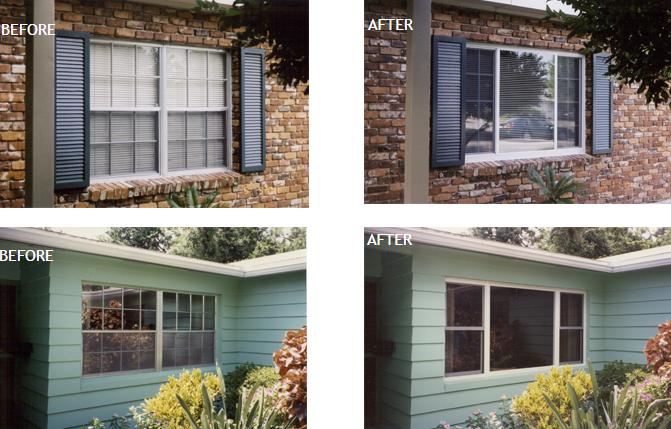Are you in the market for new windows? Whether you want to upgrade existing windows or replace old, problematic ones, you have many options to consider. Selecting new windows can feel like quite a project. American Exteriors of Orlando can make the project much easier.
Windows at every price point are an investment, and because they will likely stay in a home for many years, it is important to select wisely. Budget, function, and visual appeal are all factors to consider when deciding which frame material, pane type, and window style to choose for your replacements.
Window Materials
Window material refers to the material that makes up the actual window frame. The options for window materials each has its pros and cons. Not only the price needs to be considered, but also durability, efficiency, and style. Vinyl, fiberglass, and Fibrex are good options to keep in mind for residential window replacements.
Vinyl
Vinyl is a popular window frame material due to the following factors:
- it is inexpensive to manufacture, keeping cost low
- it is sturdy and an excellent insulator, making it a durable and energy-efficient choice
- vinyl frames and sashes will not chip, warp, or crack like some frame materials
The disadvantage of vinyl is the limited color selection.
Fiberglass
Fiberglass is becoming more popular as an alternative to vinyl. Although consumers have been a little wary of fiberglass, more are realizing that this material has excellent strength and insulation capabilities. Consider fiberglass if your home has big windows, as fiberglass holds up well under the stress of larger dimensions. Furthermore, fiberglass can be painted over (unlike vinyl), giving homeowners more freedom to customize the look of their windows.
Fibrex
Fibrex is a composite material made up of epoxy resin and wood fibers. Fibrex, like fiberglass, can be painted over, which allows for changes in frame color. It has the appearance of wood but is more durable and will not rot or deteriorate over time. Fibrex windows are also an environmentally friendly option for window replacements, as the wood fibers in the material come from byproducts of wood window production. Waste products are used to create this material, so fewer contaminants end up in landfills.
Single- or Double-Paned?
The next point to consider is whether single- or double-paned windows are the best option for window replacement in your home.
This decision comes down to budget. The benefit of single-paned windows is that they cost less; both buying and replacing these windows will be cheaper. However, though double-paned windows are more expensive on the front end, they are considered an investment. Since double-paned windows provide better insulation, they pay for themselves in the long run in lower heating and cooling bills.
Additionally, double-paned windows are an excellent option for homes near an airport or a busy street, as they block noise better than their single-paned counterparts.
Window Styles
From sash to casement windows to many designs in between, there are numerous window styles available. Some homeowners may prefer a fixed picture window to allow more light to enter a room. However, ventilation, aesthetic appeal, and even safety are factors to consider when making the final decision.
Single- and Double-Hung Sash Windows
Single- and double-hung windows refer to the number of moving panels, or sashes, that the windows are equipped with. Most standard windows are single-hung windows, with only a bottom sash that opens by sliding upward.
Double-hung windows have two operating sashes. These windows can be opened from either the top or the bottom, allowing for versatility in airflow. Upgrading from single- to double-hung sash windows does impact the budget when it is time for a window replacement.
Most single- and double-hung windows can be cleaned easily; they have tilt latches that allow the sashes to be tipped inward for easy access. These windows are simple to operate and come in various sizes and design options so homeowners can choose between a sleek or more traditional look.
Sliding Sash Windows
Sliding sash windows open horizontally. While a single sliding window opens in one direction, double sliding windows, like double-hung windows, can open from both sides and allow more air to enter the room. These windows are simple to operate and do not require lifting a sash like single- and double-hung windows do. Sliding windows may be a welcome option if you are replacing windows that have become stuck and difficult to open.
Casement Windows
A casement window, also called a tilt-and-turn window, is hinged on a single side. The standard casement window is hinged on the left or right, opening widely and creating lots of airflow. Casement windows generally leak less air, making them more energy efficient. This is because the window closes by pressing against the frame rather than sliding into it.
Awning and Hopper Windows
Additional varieties of casement windows are awning and hopper windows. These windows are, respectively, hinged on top and bottom. They are usually placed higher up on walls for the sake of privacy and better ventilation.
Awning windows are hinged on the top and open from the bottom. This style provides a roof that keeps the elements out while still letting air into the home.
Hopper windows are the opposite of awning windows. They are hinged on the bottom and open from the top, usually inward. Though hopper windows catch debris more easily than awning windows, they have their place, such as in a basement or bathroom where space is tight and privacy is important.
Bay and Bow Windows
Bay and bow windows offer a larger viewing area than traditional windows do, and the expanded dimensions allow more light to enter the room. These windows also come in different styles, from double-hung to casement to fixed. The shape and size of bay and bow windows are attractive and create curb appeal for the home, making them an excellent option when the time comes for window replacement.
Garden Windows
A garden window can create a beautiful atmosphere with its built-in shelf space, perfect for plants or vases. The window box extends outward, exposing the shelf to sunlight while protecting it from the elements, and most types have side vents that may be opened for additional airflow. If you are replacing the windows in your home and want to add beauty and character to your space, a garden window is a perfect choice.



